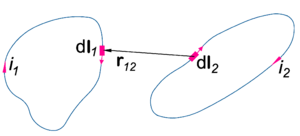Ampere's equation: Difference between revisions
imported>Paul Wormer No edit summary |
imported>Paul Wormer No edit summary |
||
| Line 2: | Line 2: | ||
Rather than giving the infinitesimal equation, which is not without problems,<ref>E. Whittaker, ''A History of the Theories of Aether and Electricity'', vol. I, 2nd edition, Nelson, London (1951). Reprinted by the American Institute of Physics, (1987). pp. 85-88 </ref><ref>C. Christodoulides, ''Comparison of the Ampère and Biot-Savart magnetostatic force laws in their line-current-element forms'', American Journal of Physics, vol. '''56''', pp. 357-362 (1988) </ref> we will describe two common cases obtained by integration: a system consisting of two straight wires and a system of two closed loops. Since the integrals over disputed terms in Ampère's infinitesimal equation vanish, the equations for these integrated systems are generally accepted and, moreover, are in full agreement with experiment. | Rather than giving the infinitesimal equation, which is not without problems,<ref>E. Whittaker, ''A History of the Theories of Aether and Electricity'', vol. I, 2nd edition, Nelson, London (1951). Reprinted by the American Institute of Physics, (1987). pp. 85-88 </ref><ref>C. Christodoulides, ''Comparison of the Ampère and Biot-Savart magnetostatic force laws in their line-current-element forms'', American Journal of Physics, vol. '''56''', pp. 357-362 (1988) </ref> we will describe two common cases obtained by integration: a system consisting of two straight wires and a system of two closed loops. Since the integrals over disputed terms in Ampère's infinitesimal equation vanish, the equations for these integrated systems are generally accepted and, moreover, are in full agreement with experiment. | ||
==Electromagnetic units== | |||
Equations<ref>J. D. Jackson, ''Classical Electrodynamics'', 2nd edition, John Wiley, New York (1975) pp. 172-173</ref> will be given in two common systems of electromagnetic units ([[SI]] and rationalized Gaussian) and to that end we define the constant ''k'' as follows, | Equations<ref>J. D. Jackson, ''Classical Electrodynamics'', 2nd edition, John Wiley, New York (1975) pp. 172-173</ref> will be given in two common systems of electromagnetic units ([[SI]] and rationalized Gaussian) and to that end we define the constant ''k'' as follows, | ||
:<math> | :<math> | ||
Revision as of 09:29, 19 February 2008
In physics, more particularly in electrodynamics, Ampère's equation describes the force between two infinitesimal elements of electric-current-carrying wires. The equation is named for the early nineteenth century French physicist and mathematician André-Marie Ampère.
Rather than giving the infinitesimal equation, which is not without problems,[1][2] we will describe two common cases obtained by integration: a system consisting of two straight wires and a system of two closed loops. Since the integrals over disputed terms in Ampère's infinitesimal equation vanish, the equations for these integrated systems are generally accepted and, moreover, are in full agreement with experiment.
Electromagnetic units
Equations[3] will be given in two common systems of electromagnetic units (SI and rationalized Gaussian) and to that end we define the constant k as follows,
Here μ0 is the permeability of the vacuum and μr is the relative permeability. The quantity c is the velocity of light in the vacuum (299 792 458 m s−1 exactly) .
Two straight, infinite, and parallel wires
Consider two wires, one carrying an electric current , the other . Both currents are constant in time; the wires are infinite, straight, and parallel. If the wires are a distance r apart, the force (per length l of wire) between them is,
The force is attractive if the currents run in the same direction and repulsive if they flow in opposite direction. This equation is used to define the SI unit of current A (ampere). Take wires in vacuum, r = 1 m, l = 1 m, F = 2 ⋅ 10−7 N , and equal currents, then the currents are equal to 1 A. Note that in SI units this implies that μ0 = 4π ⋅ 10−7 N/A2.
.
Two loops
Let and be electric currents constant in time. They run in separate loops, see figure on the right, where all quantities are defined. The total force between two loops is given by the double path integral over the loops
References
- ↑ E. Whittaker, A History of the Theories of Aether and Electricity, vol. I, 2nd edition, Nelson, London (1951). Reprinted by the American Institute of Physics, (1987). pp. 85-88
- ↑ C. Christodoulides, Comparison of the Ampère and Biot-Savart magnetostatic force laws in their line-current-element forms, American Journal of Physics, vol. 56, pp. 357-362 (1988)
- ↑ J. D. Jackson, Classical Electrodynamics, 2nd edition, John Wiley, New York (1975) pp. 172-173





